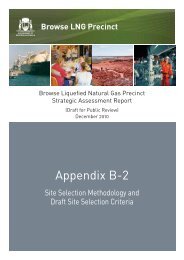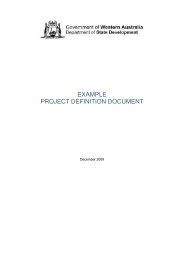Browse LNG Precinct - Public Information Booklet - Department of ...
Browse LNG Precinct - Public Information Booklet - Department of ...
Browse LNG Precinct - Public Information Booklet - Department of ...
Create successful ePaper yourself
Turn your PDF publications into a flip-book with our unique Google optimized e-Paper software.
<strong>Public</strong> <strong>Information</strong> <strong>Booklet</strong><br />
small slope downwards towards the flare, to make sure that any liquids run into the<br />
flare drum, and do not run backwards and block the flare piping. This is an important<br />
safety requirement. Placing the flares away from the coast may require piping to be<br />
placed higher than the current design and make it easier to see further away.<br />
Accommodation<br />
Questions:<br />
� What are the requirements for the accommodation camp?<br />
� Will Woodside build on a town site or not and why?<br />
The current requirement for the location <strong>of</strong> construction and operations accommodation is<br />
3 to 5 kilometres (1.9 to 3.1 miles) from the plant boundary. This is due to concerns in<br />
relation to safety, cost and community impact.<br />
Safety<br />
An accommodation facility or camp is really a place for people to live while they are<br />
working. This means it falls in the category <strong>of</strong> a ësensitive land useí and therefore must<br />
meet the defined Environmental Protection Authority requirements. As a result, the<br />
accommodation facilities must be located at least 3 kilometres (1.9 miles) away from the<br />
<strong>LNG</strong> facilities. However the maximum distance away should be kept to about<br />
5 kilometres (3.1 miles) as increasing this distance further adds to the risk <strong>of</strong> road<br />
accidents for up to 3,500 people travelling per day to and from work. Increasing the 5<br />
kilometres (3.1 miles) journey to (say) 20 kilometres (12 miles) provides 4 times the risk<br />
<strong>of</strong> accident and injury, possibly more. This is because the more driving that is done at<br />
say 100 kilometres per hour on country roads might mean more accidents due to issues<br />
relating to tired drivers not paying attention, wildlife/animals venturing onto the road at<br />
dawn and dusk and other times <strong>of</strong> the day as well as other road users driving at high<br />
speeds on the road.<br />
Cost<br />
With a shorter distance from the plant, each bus with workers on it can complete lots <strong>of</strong><br />
trips in a short amount <strong>of</strong> time meaning a smaller number <strong>of</strong> buses and drivers required.<br />
Community Impact<br />
The construction and operation phases <strong>of</strong> the plant will be on a 24 hour shift basis. It is<br />
important for the wellbeing <strong>of</strong> the workers that the accommodation is located reasonably<br />
close to the <strong>Precinct</strong>.<br />
The early thinking is that the accommodation will be high quality and have a variety <strong>of</strong><br />
recreational facilities contained within it (particularly for construction). This will assist in<br />
lowering the impact on Broome and Dampier Peninsula communities.<br />
5.3. Shore Crossing and Coastal Impacts<br />
Question:<br />
5279225 55









